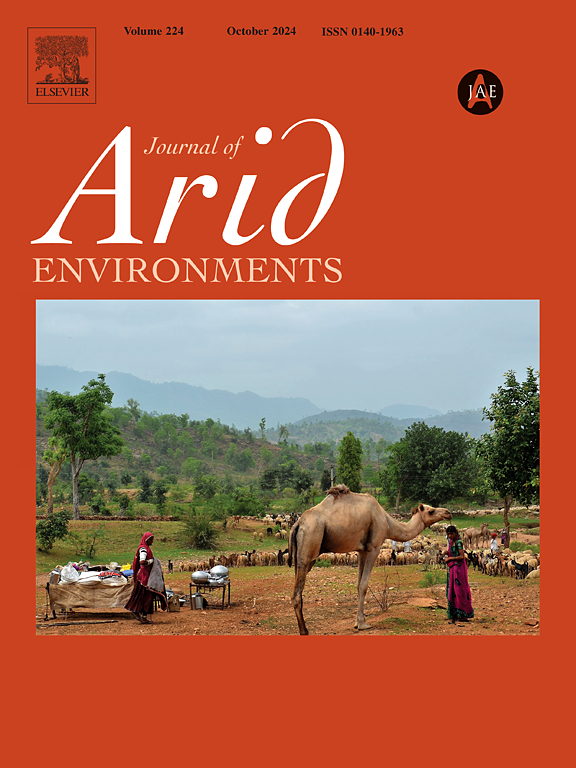GIS-based water stress analysis in North African drylands
IF 2.5
3区 环境科学与生态学
Q2 ECOLOGY
引用次数: 0
Abstract
North Africa is experiencing intensifying water stress due to rapid population growth, urban sprawl, and climate variability, with major implications for agriculture and human settlement in its predominantly dryland environment. This study applies Geographic Information Systems (GIS), remote sensing, and Multi-Criteria Decision Analysis (MCDA) to assess water scarcity across Algeria, Egypt, Libya, Morocco, Sudan, and Tunisia. Buffer zones of 10, 20, and 50 km around key river systems particularly the Nile, Draa, and Medjerda—were analyzed to evaluate spatial relationships between water access, population density, and agricultural vulnerability. The findings reveal that the 10 km buffer zone around the Nile has undergone 45 % population increase between 2000 and 2020, placing extraordinary pressure on freshwater resources and irrigated agriculture. Libya and Algeria exhibit high hydrological vulnerability, lacking perennial rivers and relying on groundwater extraction, while Morocco and Tunisia face spatially uneven water access. GIS-based zonal statistics show that regions closest to rivers not only host the densest populations but also experience the highest evapotranspiration and land-use change. Over 60 % of North Africa's landmass is classified as high or very high risk for water stress and agricultural decline, particularly in dryland zones beyond 20 km from rivers. The study underscores the critical role of rivers in structuring settlement and farming patterns, while also identifying emerging hotspots of environmental degradation in interior drylands. These results call for urgent adoption of climate-resilient irrigation, decentralized water infrastructure, and enhanced transboundary cooperation. The integrated spatial approach presented herein offers policymakers actionable, location-specific insights to guide sustainable water and land management across North Africa's fragile drylands.
基于gis的北非旱地水资源压力分析
由于人口快速增长、城市扩张和气候变化,北非正经历着日益加剧的水资源压力,这对其旱地环境中的农业和人类住区产生了重大影响。本研究应用地理信息系统(GIS)、遥感和多标准决策分析(MCDA)来评估阿尔及利亚、埃及、利比亚、摩洛哥、苏丹和突尼斯的水资源短缺情况。研究人员分析了主要河流水系(尤其是尼罗河、德拉河和梅德耶达河)周围10、20和50公里的缓冲区,以评估水资源可及性、人口密度和农业脆弱性之间的空间关系。研究结果显示,2000年至2020年间,尼罗河周围10公里缓冲区的人口增长了45%,给淡水资源和灌溉农业带来了巨大的压力。利比亚和阿尔及利亚的水文脆弱性较高,缺乏多年生河流,依赖地下水开采,而摩洛哥和突尼斯的取水空间不均衡。基于gis的地带性统计表明,最靠近河流的地区不仅拥有最密集的人口,而且蒸散量和土地利用变化也最大。北非60%以上的陆地被列为水资源紧张和农业衰退的高风险或极高风险,特别是在距离河流20公里以外的旱地地区。该研究强调了河流在构建定居点和农业模式方面的关键作用,同时也确定了内陆旱地环境退化的新热点。这些结果要求紧急采用气候适应型灌溉、分散式水利基础设施和加强跨境合作。本文提出的综合空间方法为政策制定者提供了可操作的、具体地点的见解,以指导北非脆弱旱地的可持续水和土地管理。
本文章由计算机程序翻译,如有差异,请以英文原文为准。
求助全文
约1分钟内获得全文
求助全文
来源期刊

Journal of Arid Environments
环境科学-环境科学
CiteScore
5.70
自引率
3.70%
发文量
144
审稿时长
55 days
期刊介绍:
The Journal of Arid Environments is an international journal publishing original scientific and technical research articles on physical, biological and cultural aspects of arid, semi-arid, and desert environments. As a forum of multi-disciplinary and interdisciplinary dialogue it addresses research on all aspects of arid environments and their past, present and future use.
 求助内容:
求助内容: 应助结果提醒方式:
应助结果提醒方式:


